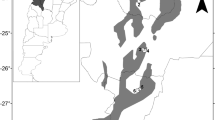Summary
-
1.
Food and foraging behaviour of the European badger (Meles meles L.) are described for a study area in south-central England, with the aim of understanding the biological function of badgers' spatial organisation. Animals were followed with the aid of radio-location and observed through infra-red night glasses.
-
2.
The diet consisted largely of one species of earthworm, Lumbricus terrestris.
-
3.
Worm abundance was measured by formalin-sampling of different vegetation types, and prey appeared to be super-abundant.
-
4.
Prey availability was restricted; badgers caught worms on the surface at night, where worms could be found in small and temporally highly unstable patches. Factors influencing the existence of these ‘worm-patches’ are discussed.
-
5.
A hypothesis is presented which suggests that the physiography of the area determined worm-patch dispersal, and thereby the range size of the badgers, whilst the number of badgers in each range, i.e. the group size, is determined by the ‘quality’ of the food patches.
-
6.
It is suggested that one of the selective advantages of a larger group size is the joint territorial defense.
Similar content being viewed by others
References
Bertram, B.: The social system of lions. Sci. Am. 232, 54–65 (1975)
Bolton, P.J.: Studies in the general ecology, physiology and bioenergetics of woodland Lumbricidae. Ph. D. Dissertation, University of Durham, U.K. (1969)
Bradbury, J.W., Vehrencamp, S.L.: Social organisation and foraging in Emballonurid bats. I. Field studies. Behav. Ecol. Sociobiol. 1, 337–381 (1976)
Bradbury, J.W., Vehrencamp, S.L.: Social organisation and foraging in Emballonurid bats. II. A model for the determination of group size. Behav. Ecol. Sociobiol. 1, 383–404 (1976)
Bradbury, J.W., Vehrencamp, S.L.: Social organisation and foraging in Emballonurid bats. III. Mating systems. Behav. Ecol. Sociobiol. 2, 1–17 (1977)
Bradbury, J.W., Vehrencamp, S.L.: Social organisation and foraging in Emballonurid bats. IV. Parental investment patterns. Behav. Ecol. Sociobiol. 2, 19–29 (1977)
Clutton-Brock, T.H., Harvey, P.H.: Primate ecology and social organisation. J. Zool. 182, 1–40 (1977)
Darwin, C.: The formation of vegetable mould through the action of worms, with observations of their habits. London: Murray 1881
Elton, C.S.: The pattern of animal communities. London: Methuen; New York: Wiley 1966
Geiger, R.: Das Klima der bodennahen Luftschicht. Brunswick: Vieweg 1961
Hancox, M.K.: Studies on the ecology of the Eurasian badger (Meles meles L.). Unpublished Report, Elton Library, Oxford (1973)
Horn, H.S.: The adaptive significance of colonial nesting in the Brewer's blackbird (Euphagus cyanocephalus). Ecology 49, 682–694 (1968)
Imanishi, K.: Social organisation of sub-human primates in their natural habitats. Curr. Anthropol. 1, 393–407 (1960)
Iversen, J.A.: Basal energy metabolism of Mustelids. J. comp. Physiol. 81, 341–344 (1972)
Jarman, P.J.: The social organisation of antelope in relation to their ecology. Behaviour 58 (3, 4), 215–267 (1974)
Kollmannsperger, F.: Über Rhythmen bei Lumbriciden. Decheniana 108, 81–92 (1955)
Krebs, J.R., MacRoberts, M.H., Cullen, J.M.: Flocking and feeding in the Great Tit Parus major-an experimental study. Ibis 114, 507–530 (1972)
Kruuk, H.: The spotted hyena. Chicago and London: University of Chicago Press 1972
Kruuk, H.: Functional aspects of social hunting by carnivores. In: Function, and evolution in behaviour. Baerends, G., Beer, C., Manning, A. (eds.), pp. 119–141, Oxford: Clarendon Press 1975
Kruuk, H.: Spatial organisation and territorial behaviour of the European badger, Meles meles L. J. Zool. 184, 1–19 (1978)
Kruuk, H., Sands, W.A.: The aardwolf (Proteles cristatus Sparrman 1783) as predator of termites. E. Afr. Wildl. J. 10, 211–227 (1972)
Lakhani, K.H., Satchell, J.E.: Production by Lumbricus terrestris (L). J. Anim. Ecol. 39, 473–492 (1970)
Lampe, R.P.: Aspects of the predatory strategy of the North American badger, Taxidea taxus. Ph. D. Dissertation, University of Minnesota (1976)
Lawrence, R.D., Millar, H.R.: Protein content of earthworms. Nature (Lond.) 155, 517 (1945)
Mech, L.D.: The wolf. New York: Natural History Press 1970
Monteith, J.L.: Dew: Facts and Fallacies. In: Water relations of plants. Rutters, A.J., Whitehead, F.H. (eds.), pp. 37–56. Oxford: Blackwells 1963
Neal, E.G.: The badger. London: Collins 1948
Neal, E.G.: Badgers. Poole: Blandford Press 1977
Neal, E.G., Harrison, R.J.: Reproduction in the European badger (Meles meles L.). Trans. Zool. Soc. London 29, 67–130 (1958)
Paget, R.J., Middleton, A.L.V.: Badgers of Yorkshire and Humberside. York: Ebor Press 1979
Raw, F.: Estimating earthworm populations by using formalin. Nature 184, 1661–1662 (1959)
Reynolds, E.R.C., Leyton, L.: Measurement and significance of throughfall in forest stands. In: Water relations of plants. Rutters, A.J., Whitehead, F.H. (eds.), pp. 127–141. Oxford: Blackwells 1963
Ryszkowski, L., Wagner, C.K., Goszczynski, J., Truszkowski, J.: Operation of predators in a forest and cultivated fields. Ann. Zool. Fennici 8, 160–168 (1977)
Satchell, J.E.: Lumbricidae. In: Soil biology. Burges, A., Raw, F., pp. 259–322. London, New York: Academic Press 1967
Schaller, G.B.: The Serengeti lion. Chicago: University of Chicago Press 1972
Siegel, S.: Non-parametric statistics for the behavioural sciences. New York: McGraw-Hill 1956
Skoog, P.: The food of the Swedish badger, Meles meles L. Viltrevy 7, 1–120 (1970)
Svendsen, J.A.: The behaviour of Lumbricids under moorland conditions. J. Anim. Ecol. 26, 423–439 (1957)
Voigt, G.K.: Distribution of rainfall under forest stands. Forest Sci. 6, 2–10 (1960)
Author information
Authors and Affiliations
Rights and permissions
About this article
Cite this article
Kruuk, H. Foraging and spatial organisation of the European badger, Meles meles L.. Behav Ecol Sociobiol 4, 75–89 (1978). https://doi.org/10.1007/BF00302562
Received:
Issue Date:
DOI: https://doi.org/10.1007/BF00302562




